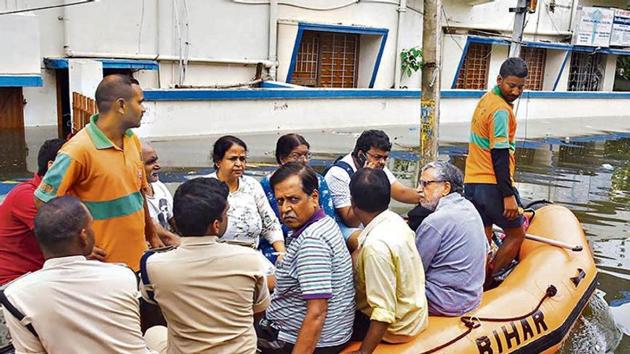Heaviest monsoon rain in 25 years, says IMD
But the withdrawal of the monsoon is likely to begin only around October 10 — the longest delay since data first started being recorded.
New Delhi: The India Meteorological Department announced the end of the 2019 southwest monsoon season on Monday and said that the country had received the heaviest showers in 25 years with 110% of the long-period-average (LPA) rainfall.

But the withdrawal of the monsoon is likely to begin only around October 10 — the longest delay since data first started being recorded. The previous record for the longest delay of the summer monsoon was in 1961: October 1. The monsoon usually starts withdrawing in the first week of September from northern India.
The onset of the summer monsoon was late this year: June 8, and rainfall by deficient by 33% at the end of the month. But July, August and September received 105%, 115% and 152% of their LPA, respectively.
IMD had predicted a near normal monsoon at 96% of LPA in May but had not forecast the prolonged season.
“IMD had predicted that the monsoon performance would be better in the second half compared to the first half. IMD’s analysis on weakening of El Nino and development of a positive Indian Ocean Dipole (IOD) and the second half monsoon rainfall being above normal were thus proved correct. However, quantitatively, realised rainfall during the second half was more than what IMD predicted,” a statement by the agency said.
“We will not consider the rainfall received after this to be monsoon rainfall. It will be counted as post-monsoon season rainfall. IMD considers June, July, August and September as monsoon season,” said M Mohapatra, director general, IMD.
A depression over Saurashtra and the adjoining Gujarat region has moved eastwards and is presently centered over northern parts of Gujarat region. It is very likely to move northeastwards and weaken gradually into a well-marked low pressure area by October 1. Under its influence. widespread to very heavy rainfall is likely over Saurashtra, Kutch, north Gujarat region and southeast Rajasthan till October 2 and isolated heavy rain over north Gujarat region and East Rajasthan is also likely, said experts.
Climate scientists said the IMD had neither updated its monsoon withdrawal date for decades nor factored in changes in recent years. For the last 10 years, the monsoon is beginning its retreat after September 20.
“The northeast monsoon [winter rains in peninsular India] usually arrives in October. We don’t have any update on northeast monsoon yet,” added Mohapatra.
Out of 36 meteorological subdivisions, two sub divisions received “large excess” (60% over LPA), 10 received excess (20% to 59% over LPA) and 19 got normal monsoon (-19% to 19% over LPA ) rainfall. But five sub-divisions received deficient rainfall.
In Haryana, Delhi and Chandigarh, the rainfall deficiency was roughly 42%. “On an average, about 20% of area of the country receives deficient or scanty rainfall during the monsoon season,” the IMD statement said.
The defining feature of this year’s monsoon was the high number of extreme rain events. For example, there were 1,269 weather stations reporting very heavy and extremely heavy rain in August out of which 282 were extremely heavy rainfall events, the highest in the past five years. The data on extreme events is yet to be compiled by IMD.
IMD officials said the delayed withdrawal of the monsoon is a feature of climate variability. “Monsoon withdrawal always begins from the northwest part of the country. The first and foremost condition to announce monsoon withdrawal is that rainfall should stop completely for about five days, there should be significant reduction in moisture and anticyclone flow should be established. None of this has happened yet,” said K Sathi Devi, Head of the National Weather Forecasting Centre.
“June to September is the normal monsoon season but variability can happen. We need to see long-term data to conclude whether this is a result of climate change. Extreme rain events,however, can be definitely linked to climate change. There is a rise in extreme rain events in recent years. In August this year there were more than 1,000 extreme rain events,” said Pulak Guhathakurta, head, Climate Application and User Interface, Climate Research and Services at IMD Pune.
But projections made by a team of scientists at the Indian Institute of Tropical Meteorology (IITM) Pune based on various models show an intensification of the southwest monsoon and an increase in the mean monsoon rainfall by mid-century.
“A series of low-pressure systems from the Bay of Bengal are responsible for the monsoon’s delayed withdrawal from Western Rajasthan this year. Conditions had become favourable for the monsoon’s withdrawal from western Rajasthan around September 18. However, a low-pressure circulation [which seeded Tropical Cyclone Hikka in the Arabian Sea] changed the wind pattern over the state and caused a further delay in the monsoon’s withdrawal,” said Akshay Deoras, a doctoral researcher at the department of meteorology, University of Reading .
“Currently, atmospheric conditions over extreme western Rajasthan don’t completely indicate the presence of the monsoon - there is a significant reduction and cessation of rainfall, moisture has considerably reduced and more importantly, winds near the ground and at higher heights don’t indicate the monsoon pattern. However, the withdrawal is unlikely to be officially announced that soon since the region is expected to witness some more rainfall activity early October which won’t be related to the monsoon. This is among the limitations of the withdrawal criteria,” he added.
Get Current Updates on India News, Lok Sabha Election 2024 live, Infosys Q4 Results Live, Elections 2024, Election 2024 Date along with Latest News and Top Headlines from India and around the world.



